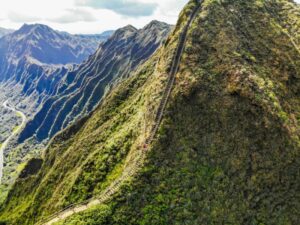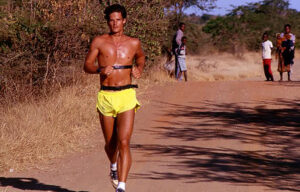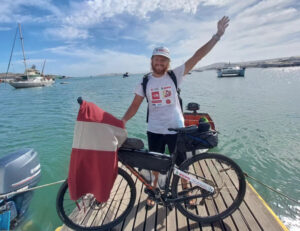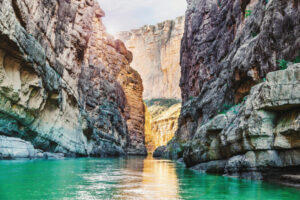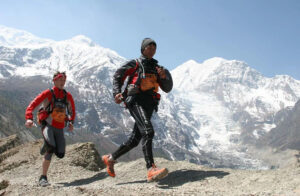Yann Busnel is attempting to travel “the longest land route in the world”. On January 3, the 35-year-old Frenchman started his journey in Cape Agulhas, the southernmost point of Africa. Over the next four years, he plans to travel 50,000 kilometers to Cape Horn, at the bottom of South America.
His expedition, which he has titled Beyond the Capes, will be completely human-powered. He will hike, cycle, ski, longboard, kayak, canoe, and will even use a camel.
Busnel has already made his way through Africa and is currently trekking across Saudi Arabia. He spoke to ExplorersWeb about his journey.
This interview has been edited for brevity and clarity.

The route. Photo: Beyond the Capes
Avoiding unsafe lands
You say you are taking the longest land route in the world but you will use a kayak for some sections. Can you talk us through the route?
This is the longest route between two points on earth across land. I am traveling from South Africa to South America via the Bering strait. Unfortunately, there are a few areas where it is not safe enough for me to travel overland, and others where it just isn’t possible.
For example, between Djibouti and Saudi Arabia, I used a kayak and a sailboat. I will have to cross the Bering Strait by sea because, since 2008, there has not been enough sea ice to walk across. The Hormuz Strait is not possible for me to cross because of the situation in Iran, so I plan to use a homemade sailboat. None of this really matters. The distance is still over 50,000km between the two points. There is no other longest way.
Since setting off, I have crossed South Africa, Botswana, Zimbabwe, Zambia, Malawi, Tanzania, Kenya, Ethiopia, and Djibouti. After passing between Eritrea and Yemen, I am now in Saudi Arabia. From here, I will go to the UAE, then Oman, Pakistan, China, Mongolia, Russia, Alaska, Canada, the U.S., Mexico, Guatemala, Salvador, Honduras, Nicaragua, Costa Rica, Panama, Colombia, Ecuador, Peru, Chile, and Argentina. I will end in Ushuaia.
Following a dream of exploration
You talk about a couple of goals for this journey: doing something no one has done before and better understanding human adaptation. Explain your approach.
This expedition has many goals, but the most interesting one for me is the physical and mental challenge. I want to see how my body and mind will change and adapt. There are so many elements: solitude, physical difficulties, pain, cold, heat, and constantly being outside and away from home.
The second big part of this journey is sharing. I will come across many tribal peoples, I am trying to understand our world and its different cultures. I want to share this on social media, and hopefully, make people dream of traveling.
The third purpose of this expedition is my favorite. It’s to understand lifestyle and evolution. People have to adapt as the world around them transforms. I love all these things, how to survive with nothing, why people do things one way and not another.
Doing something nobody has done before was another motivation. I dream of being a pioneer and feeling what great explorers felt. I always thought it was impossible: Many explorers told me that everything has already been done. But I finally found this project and it makes me so happy.
From duo to solo
Where did this idea come from?
I always wanted to explore the world and do great things. My hometown of Brittany, France, is full of great stories, great explorers, and adventurers. I always dreamed of being part of that.
This idea came to me when I reversed the “classic” map view of our world. I realized that the longest itinerary was in front of my eyes. Initially, I was going to do this with my brother. But life changed, he met his fabulous wife and now I am doing a zero-emission journey and he is backstage taking care of me. I couldn’t do it without him.

Yann Busnel and his camel. Photo: Beyond the Capes
How long do you expect this to take?
About four years. Some parts, such as the section I’m doing right now, are very slow. Walking through a desert takes time. At the moment, my camel is ill, so we have had to rest quite a lot over the past few days. In comparison, when I use a bicycle, I feel like a rocket! The different terrain and ways of traveling break up the journey and mean that nothing happens at the same speed.
I have three years to go until I arrive at Cape Horn. Truthfully, that thought is one of the hardest parts of this adventure. I am not going home before I reach the end. There will be no interruptions and that is a long time to be on the road and away from the people you love.

Photo: Beyond the Capes
Camel for kayak swap
How much of the route was pre-planned before you set off?
I am an ex-soldier and I used the skills I learned in the army to prepare. Everything, all the roads and routes, has been pre-planned. I have been working on this for 10 years. But things change every day, and I adapt. Luckily, other than a few kilometers here and there, my original route has not changed much so far.
I will try to stick to my plan but you have to find solutions as problems arise. I’ve been fighting for two months now to save my camel and to cross borders with him. Our world is complicated. The logistics are the worst part. You end up in odd situations. For example, I did not have enough money to ship my kayak back to France and buy the camel. A Saudi guy offered me a camel in exchange for my kayak. I accepted, but now I don’t have a kayak and will need to find one again later in the trip.
Are there any countries you are concerned about traveling through?
Not really. People tend to think about what is coming next and forget about enjoying the moment. I’m trying not to do that, though sometimes it can be difficult with all the planning.
Some countries will be more complicated. Russia for example. I hope the war will end soon. China has now reopened, so I am really happy about that. I thought I was going to have to come up with a detour.
The few kilometers before borders are when I worry the most.

Photo: Beyond the Capes
How much gear are you carrying with you?
It depends on my support and how I am traveling. Rouhoul [the camel] is carrying 130kg. He has all the water and food we will need to cross the desert. On the bicycle, I had about 50kg. That included everything: water, food, solar panels, power banks, clothes, spare bicycle parts, a sleeping mat, a sleeping bag, etc.

Photo: Beyond the Capes
Some highlights
What has the hardest challenge been so far?
I am a man of action. I cannot stay in one place long without anything to do. So the hardest challenge was being stuck in Djibouti for three months because of the wind.
Eritrea was also an unfriendly place. It’s a closed country, a bit like North Korea. If you want to visit it as a tourist, you can, but they want you to stay in the capital city. I wanted to kayak along the coastline. Their army did not like that. They seemed to think I was dangerous.
What will be the biggest challenge going forward?
There are many, but the biggest will be the polar section and the Rub Al Khali desert in a few days. They are each so remote, and I will be in a dangerous situation if anything goes wrong. In the Rub Al Khali, there is no water and the sand dunes are difficult to move through.
Another challenging section will be crossing the Bering Strait by kayak, because of both the conditions and the logistics. I hope everything will be fine with the visa and papers I need.
Other difficult points will be the Darien Gap, the Oman Gulf, the Himalaya, crossing Canada on foot, and kayaking along Alaska’s coastline.
It begins with maps
How do you prepare for an expedition like this?
For many years, the most important part has been to visualize everything. To ask myself if I’m ready for each part and to answer truthfully. For the physical element, I have trained in the military and played many sports for years.
Another important part is the maps. They’re the beginning of the adventure. I had to prepare intelligently. Often I would find myself stuck, unsure how to get to the next place. You have to be patient. I love the quote, “He didn’t know it was impossible, so he did it.”
It wasn’t just me preparing. Lots of people were involved and still are. I speak to my logistical team as often as I can, sometimes for directions but often because it’s the only way to escape my mind. They are my family, my best friends.

Photo: Beyond the Capes
You can follow Busnel’s journey here.

